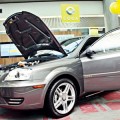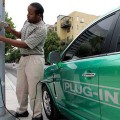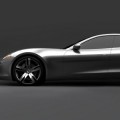I put the hammer down at the CODA representative’s cue. The car responds quickly, doling out a near-excessive amount of speed. It’s a neighborhood, so I ease off the pedal. The regenerative brakes kick in and start to slow the car a bit. I don’t really care how fast we’re going—I’m focused on the chassis and the ride—but as we continue the drive, I find myself drawn back to the accelerator: I’m startled how fast 134 electrically-charged horses can push.
CODA is an oddball brand with a product that’s an assemblage of many different parts and pieces. The 134-horsepower electric motor is made by UQM in Colorado, while Chinese-based Tianjin Lishen Battery Co. (OEM to Apple, Motorola and Samsung) produce the batteries. The body stampings are similarly made in China at Hafei’s factories. Borg-Warner’s transmission comes from Michigan. Porsche assisted CODA with design of the car’s steering system. Continental is responsible for the brakes. Final assembly happens in the East Bay, in Benicia.
What brought me into the electric car’s cockpit, cruising down Stevens Creek Boulevard, is the new CODA dealership—the only one of its kind in Northern California. Shaun Del Grande, president of Del Grande Dealer Group (DGDG) in Santa Clara, decided a year ago he wanted to include sales of an electric vehicle brand in his family’s ever-growing fleet of auto dealerships. The Del Grandes have been running dealerships in the South Bay for four decades, starting with Shaun’s father, Kevan.
Targeting the usual suspects—Tesla Motors, Fisker—it wasn’t until Shaun Del Grande stumbled upon Santa Monica-headquartered CODA Automotive that he had his answer. With CODA’s opening on March 16, DGDG now sells 11 car makes in the Bay Area.
“We have been selling Nissan Leafs and Chevrolet Volts for some time now, noticing the huge demand,” Del Grande says. “So, we made it a priority to research what else is out there in terms of 100 percent electric vehicles and CODA was our answer.”
Yet another player in the California electric vehicle (EV) game, Coda is the only one not currently sitting on the sidelines. Its most notable EV competitor, San Bruno-based Tesla Motors, isn’t sending any cars out of its Fremont factory doors. The company remains busy ramping up production of its highly-anticipated Model S sedan after shelving its six-figure sticker price Roadsters.
Tesla slated Model S deliveries to start earlier this year, but the release date for sedans slipped to “mid-2012” after many customers ponied up $5,000 for a preorder. Meanwhile, CODAs—priced at $38K for a standard model, about $20K less than the Model S—are being assembled on the factory floor and winning the sales race simply by having a product available to drive now.
“If consumers want an electric car, then the one they’re going to get is a CODA—if they can go out and buy one there and then,” says Blake Z. Rong, associate online editor for Automobile.com. “It’s kind of a first-come, first-served thing. If you want a Tesla, you’re going to have to wait for it.”
The two companies target two different segments of the EV demographic, but there is a question some in the hybrid and voltage community have started to wonder: Could customers shopping for a California-grown EV tire of Tesla’s delays and look to the CODA line when they’re ready to stop suckling from Big Petroleum’s oily teat?
In 2006, Chris Paine released the first of two documentaries looking at the electric automotive industry. His films Who Killed The Electric Car? and Revenge of the Electric Car challenged big oil, the automotive industry and even viewers on what was being done to wean drivers off their insatiable appetite for gas guzzlers.
On the horizon of having several options—CODA, Tesla, Nissan’s Leaf—Paine says the more companies consumers can choose from, the more likely habits will change. “Electric cars have got to move from the early adopter to the every adopter,” he says.
{pagebreak}
The car that comes closest to the CODA in price and size is the Leaf. Nissan’s EV feels better built and has an interior certainly nicer to sit in, but it lacks the zip of the CODA. Instead, the Leaf focuses on keeping the driver in tune with the efficiency of the car. Assuming you can find one and the local dealer hasn’t marked up the price, the Leaf starts at $35K.
Regardless of price, though, Paine says that once consumers get a chance to try electric cars, there’s nothing to compare. “They’re like what the iPhone was to cell phones,” he says. “I don’t know anybody that’s gone back. You get spoiled quickly. That’s why Tesla and CODA didn’t go for a plug-in hybrid.”
As surprisingly solid as it may be, the CODA sedan is far from a perfect car. The interior is dark, feels a little cramped and, at least in the preproduction unit I drove, chintzy. The chrome door pulls are thin, flimsy, chromed plastic. A piece of leather stitched to the parking brake handle was ill-fitting. The brake pedal lacked feeling, but I was informed that it’s due to a software patch missing in this version of the car. The driver’s side door armrest was too low for me to rest my arm on which was irksome.
But the benefits are numerous: driving 125 miles per charge can convert gas stations into concession stands; EV parking spaces resided in premium spots, assuming you can find the spots—there are only about 40 total spaces provided by the city of San Jose; and then there is the low upkeep costs. According to CODA, annual maintenance comes in under $1,000. Even wear and tear items like brake pads should last as long as 100K miles due to the car’s regenerative braking system.
The braking feature offers a clever way for hybrids and all-electric cars to reclaim energy that would normally be lost. In essence, the motor in the car is turned into a generator when it’s not required to provide forward motion. The car’s motor then sends power back to the battery pack while slowing the car with friction.
The trappings in the CODA clearly slot it into a different class from Tesla’s luxury sedans. CODA opted for a 20th century-style dashboard layout, and, although Bluetooth and navigation are standard, the car eschews a fancy wireless key and pushbutton start for a familiar insert-and-twist key. Tesla, on the other hand, wants to appeal to the iPad generation with a 17-inch touchscreen replacing the entire center console in the Model S.
“It’s like comparing a Jetta Diesel to a Mercedes S-Class Bluetec,” says Automobile.com’s Rong. “The level of luxury, fit, finish and features are worlds away from each other even though they both share a common power plant.”
In spite of CODA’s imperfections, Shaun Del Grande is betting big on the company’s future. The dealer group hired a full-time director of electric vehicles and has plans to open four more CODA dealerships throughout Northern California.
Paine says the future of California’s electric car market has an endless amount of possibilities, and it will be up to Tesla’s competitors to capitalize now before the heavyweight gets its act together.
“[Tesla’s] in an awesome position,” Paine says. “They have patents. They have two products in the pipeline. They’ve got an incredible factory in the East Bay. … This is a new era and Tesla, and anybody doing electric, is in a great position to take advantage of that.”
For now, while prospective Tesla owners are forced to dream of their cars, CODA owners could be zipping by on Bay Area freeways.rospective Tesla owners are forced to dream of their cars, CODA owners could be zipping by on Bay Area freeways.
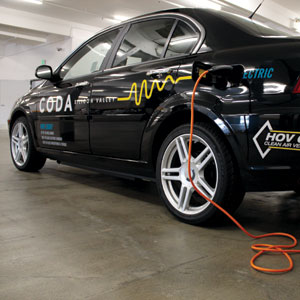
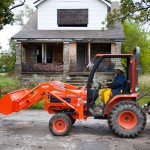 Food Forward to air on PBS
Food Forward to air on PBS 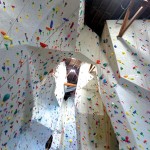 Touchstone Climbing Gym Opens in San Jose
Touchstone Climbing Gym Opens in San Jose 